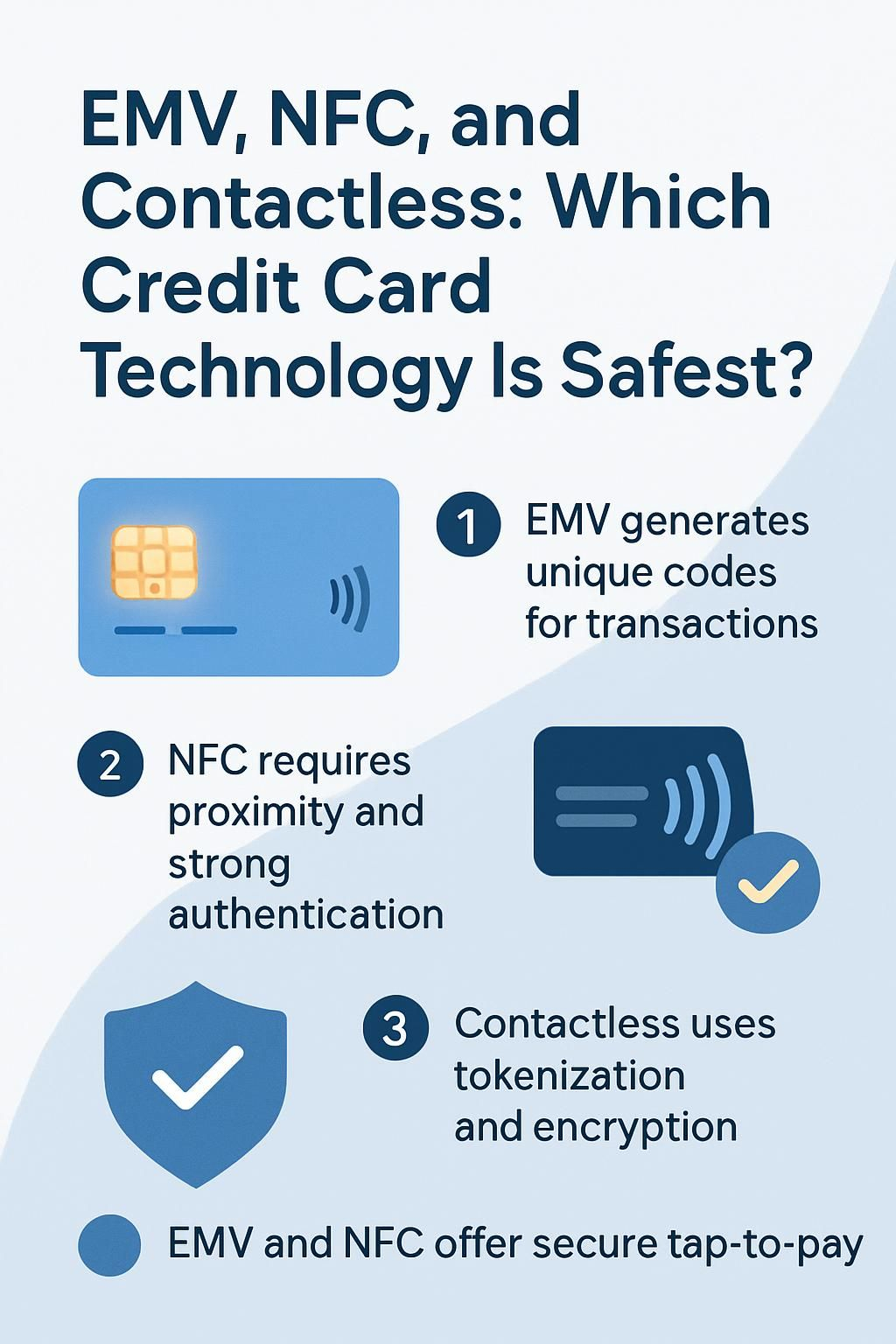EMV, NFC, and Contactless: Which Credit Card Technology Is Safest?
Are you worried about keeping your credit cards safe when tapping to pay or using mobile wallets? Newer payment methods like EMV chip cards, contactless payments, and NFC technology have made fraud much harder for thieves than with old magnetic stripe cards.
This post breaks down how each technology works to protect your card information at the checkout counter and online. Keep reading to find out which option gives you the best security.
Key Takeaways
- EMV chip cards generate unique cryptographic codes for each transaction, significantly reducing the risk of fraud. This technology, introduced widely after 2015 in response to rising credit card fraud from magnetic stripes, makes cloning and unauthorized use of stolen data nearly impossible.
- NFC payments offer enhanced security through short-range communication that requires physical proximity (a few centimeters) to the payment terminal. Combined with strong encryption and user authentication methods like PINs, fingerprint scans, or face recognition, NFC minimizes risks of unauthorized access and data interception during transactions.
- Contactless payments utilize tokenization and dynamic data encryption to protect card information during transactions. By replacing sensitive account details with a digital token that changes with every transaction, these systems nearly eliminate the threat of skimming and fraudulent reuse.
- Integrating EMV chip technology with NFC enables both convenience and high-level security for credit card users. This combination supports secure tap-and-pay functionality on mobile wallets like Apple Pay and Google Pay while ensuring sensitive information is safeguarded against cyber threats.
- For international travelers in 2025, selecting credit cards offering no foreign transaction fees, extensive travel insurance benefits, compatibility with mobile wallets for contactless payments using near-field communication (NFC), universal acceptance through Visa or Mastercard networks, along with round-the-clock global customer support will provide financial flexibility as well as assured security across different regions.

How EMV Technology Ensures Security

EMV chips create a new code for every purchase, making stolen data useless for future fraud. Credit card companies use this technology in EMV cards and payment terminals to make card cloning much harder than with magnetic stripe cards.
How does EMV generate dynamic data for each transaction?
Each time you tap your emv card or insert it into a payment terminal, the chip produces a one-time cryptographic code for that purchase. This unique transaction number changes with every payment and serves as a digital fingerprint to verify your card’s authenticity at point of sale.
Even if someone intercepts your information through credit card skimmers, the dynamic data becomes useless for future transactions.
Instead of using your actual card number during emv payments, the smart chip creates a temporary digital identifier known as a token. Payment terminals then use this token along with encrypted details to confirm secure transactions.
Credit card companies introduced this method after 2015 in response to rising fraud linked to magnetic stripe cards, making it nearly impossible for hackers to reuse stolen data from contactless credit cards or debit cards powered by emv technology.
Why is EMV resistant to card cloning and fraud?
EMV chip cards make card cloning almost impossible because they generate a new, unique cryptographic code for every transaction you complete. If someone tries to steal your information by skimming the data, it will not work on any other purchase; the dynamic code changes and makes stolen data useless.
EMV payments use encrypted sensitive information so even if a hacker grabs transaction details from a compromised payment terminal or card reader, they cannot access or reuse that encrypted information.
A personal identification number (PIN) and sometimes multifactor authentication add extra layers of security to EMV cards at most merchants worldwide after 2015’s global upgrade.
Contactless cards powered by near field communication further reinforce this system with tokenization—a process where a digital identifier replaces your actual credit card number during purchases in places like Apple Pay or Google Pay apps.
As someone who travels abroad often and uses both mobile wallets and physical EMV chip cards, I’ve found my transactions stay safe across various merchant accounts. This level of fraud prevention is why many banks and payment processors now recommend switching from magnetic stripe cards to smart devices enabled with contactless technology for all high-value customers.
What Are the Security Features of NFC Payments?
NFC payments use near-field communication to send payment information securely between your phone or smartwatch and a payment terminal. Digital wallets like Apple Pay and Google Pay store your card data safely behind strong encryption barriers, making mobile payments safer at checkout.
How does short-range communication control NFC transactions?
Near field communication keeps transactions safe by limiting the signal range to just a few centimeters. Payment terminals only respond when your contactless card, smartphone, or wearable device is close enough for tap to pay.
This small range blocks criminals from intercepting your data across distances.
Each time you use Apple Pay or Google Pay with an NFC reader at a point of sale terminal, the system generates a unique cryptographic code. Sensitive information stays encrypted during transmission and never passes in plain text to the payment processing company like First Data or Clover.com.
The result: no one can reuse old stolen details from EMV chip cards or mobile payments for fraud.
User authentication methods such as fingerprint scans, PINs, and face recognition add another barrier that prevents unauthorized access through digital wallets or smart cards. Now see how PIN numbers, Touch ID, and Face ID work together to verify users in NFC payments.
How do PIN, fingerprint, or face ID authenticate NFC payments?
PIN, fingerprint, or face ID act as gatekeepers for NFC payments in mobile wallets like Apple Pay, Google Pay, and Samsung Pay. These authentication methods require user verification before activating the payment app or sending information to a payment terminal.
For instance, your smartphone will not approve contactless credit card transactions unless you enter your PIN or scan your fingerprint or face. This layer of device-level authentication complicates attempts to steal or misuse card data.
NFC payments rely on multifactor authentication to ensure only authorized users can complete transactions at an NFC reader. The process reduces the risk of unauthorized access by demanding two types of proof: something you have (the phone) and something you know (your PIN) or are (your fingerprint or face).
By integrating these security checks with near field communication technology, each transaction remains secure against fraudsters aiming to exploit digital wallets and smart devices for card payments.
What Are the Advantages of Contactless Payments?
Contactless cards let you pay fast and safely with just a tap at any payment terminal. Apple Pay, Google Pay, and other digital wallets use near field communication in smart devices to make secure credit card payments easy in stores.
How is sensitive data encrypted during contactless transactions?
Sensitive data never travels in its original form during contactless transactions. Instead, systems like Apple Pay and Google Pay use strong encryption to turn each payment into a secret code that only the payment terminal and your bank can read.
Each time you tap your smart device or contactless credit card at a POS terminal, the EMV chip creates a unique cryptographic value—different every single transaction. Hackers intercepting this wouldn’t get your real card number but just unusable noise.
A digital token replaces your actual account number, providing an extra shield even if someone tries to spy on radio-frequency identification signals with specialized readers. This method renders any stolen data useless for future purchases or cloning attempts; banks introduced it after 2014, and it has nearly eliminated card-present fraud at EMV terminals by over 70 percent according to industry reports.
Facial recognition or PIN entry often adds another layer before funds ever leave your account.
Each purchase creates its own secret message, leaving nothing for thieves to steal, says security specialist Dr. Lila Brenner.
This level of protection makes sensitive financial details almost impossible to crack during NFC payments through mobile wallets or wearable devices.
How does tokenization help prevent fraud in contactless payments?
Data encryption locks down your card details during contactless payments, but tokenization takes security a step further. Tokenization replaces your real credit card number with a unique digital code known as a “token” every time you pay with Apple Pay, Google Pay, or another mobile wallet.
This process uses advanced EMV technology to generate dynamic information for each transaction at payment terminals and NFC readers.
Thieves can’t use intercepted data because tokens never reveal actual credit card numbers—only randomized digital strings. Even if someone accessed the codes from an NFC payment or contactless EMV chip card, they could not reuse them for future purchases.
Major banks and payment networks have seen counterfeit fraud rates drop since adopting this system in 2019. Using my own smartphone on shopping trips worldwide has shown how effortless and secure these digital wallets can be compared to traditional magnetic stripe cards or basic chip-and-PIN setups.
EMV vs. NFC: Key Differences in Security
EMV chip cards use dynamic codes, while NFC payments rely on encrypted wireless signals to secure your purchase. Each method has its own strengths and weaknesses that can affect how safe your money and information stay during transactions at payment terminals or through digital wallets like Apple Pay or Google Pay.
How do transaction authentication methods differ between EMV and NFC?
EMV payments rely on a chip-and-PIN system, where you insert your card into the payment terminal and enter your PIN to verify the transaction. Each time you use an EMV chip card, it creates a unique cryptographic code that prevents fraudsters from copying or reusing your information.
NFC payments, like Apple Pay and Google Pay, add extra layers of security through multifactor authentication methods such as fingerprint scans or face recognition before completing transactions with mobile wallets or smart devices.
Contactless EMV cards also use near-field communication to communicate with NFC readers while maintaining dynamic data encryption for every purchase. “Each tap generates a one-time cryptogram, making every transaction unique,” says Visa’s Head of Digital Solutions in 2023.
Biometric verification on smartphones gives NFC payments another level above standard chip-and-PIN by tying the process directly to the device owner’s identity. Both contactless credit card methods keep sensitive details safe using tokenization and advanced private key protocols at payment terminals worldwide.
What vulnerabilities exist for EMV and NFC technologies?
EMV chip cards protect against many threats, but they still have vulnerabilities. Skilled criminals can use a “shimming” device to capture data from the chip at payment terminals.
Although this data does not let attackers clone your card for in-person payments, it may be used for online fraud if two-factor authentication or one-time security codes are missing.
NFC payments face risks too; an attacker with a hidden NFC reader could trigger an unauthorized transaction if your contactless credit card is close to their scanner in public spaces.
Short-range communication keeps this threat small, yet mobile wallets on smart devices must still rely on strong PINs, biometrics like Face ID or fingerprint authentication, and encrypted tokenization.
Fraudsters always target older magnetic stripe cards since those lack modern EMV or NFC technology protections. Yet, even chip and pin transactions can be compromised at poorly secured payment terminals that do not support up-to-date software.
Digital wallets and wearable devices linked to Apple Pay or Google Pay offer extra security features such as dynamic tokens and advanced encryption; still, weak passwords or lost phones introduce new dangers without careful setup of lock screens and multifactor authentication (MFA).
As someone who often uses both physical cards and mobile wallets for travel and luxury shopping worldwide, I have seen that no method is immune unless you stay alert about where your card details end up during every transaction.
Combining EMV and NFC for Maximum Protection
EMV chip cards with contactless features use both secure chips and near-field communication. Mobile wallets like Apple Pay and Google Pay blend these technologies to give you strong payment security on smart devices.
How do contactless EMV cards work?
Contactless EMV cards use near field communication technology to let you tap and pay at payment terminals instead of swiping. Each time you make a purchase, the card creates a unique cryptographic code that works only for that transaction.
That means even if someone intercepts your data, they cannot reuse it to make other payments. Sensitive information travels in encrypted form between the contactless credit card and the nfc reader; hackers cannot read or clone this dynamic data.
Most luxury retailers worldwide have switched to accepting emv chip cards with nfc features because these secure transactions prevent fraudulent charges and cut down on counterfeit fraud.
Many of my clients enjoy using Apple Pay or Google Pay through their mobile wallets since this payment method combines real convenience with strong security built into both smart devices and wearable devices.
With every tap, your contactless card shields sensitive details behind advanced encryption.
Extra authentication, such as fingerprint or PIN via digital wallets, brings an added layer of safety to high-value purchases over $1000. This blend sets up perfect conditions for exploring how integrating NFC and EMV technologies provide maximum protection against cyber criminals next.
What are the benefits of integrating EMV and NFC technologies?
Integrating EMV and NFC technologies creates a powerful combination for credit card security. EMV chip cards generate unique cryptographic codes with each transaction, which makes stolen information useless for fraudsters.
Near-field communication adds the speed of tap-to-pay using mobile wallets or wearable devices like Apple Pay and Google Pay on payment terminals that support contactless payments.
Each time you use your digital wallet at an NFC reader, device-level authentication—such as fingerprint or face ID—adds another layer of safety. Merchants who adopted these secure methods after the 2015 rollout saw counterfeit fraud drop sharply.
This fusion gives you both convenience and peace of mind when making purchases in stores around the world. Sensitive data travels through encrypted channels during every transaction.
Tokenization replaces actual card details with temporary digital tokens, keeping your payment info safe from cybercriminals trying to hack into systems that rely on magnetic stripe cards.
Payment methods combining smart devices, EMV chips, and near-field technology deliver security features built for international travelers seeking quick yet protected transactions wherever they go.
What Are the Best Credit Cards for International Travelers in 2025?
Choosing the optimal credit cards for international travel in 2025 requires a thorough examination of their benefits and safety parameters. These cards are required to offer financial agility and assured security for transactions around the globe.
- Credit cards that waive foreign transaction fees are beneficial as they allow travelers to save a substantial amount of money. A significant number of credit cards levy a fee of up to 3% for each overseas transaction. However, the premier options eradicate these charges, making every expenditure more cost-effective.
- Credit cards that provide expansive travel insurance are excellent for covering unpredictable events. This insurance includes aspects such as trip cancellations, medical emergencies, and lost luggage, offering a sense of security to travelers.
- Reward programs that focus on travel can reveal extraordinary value. Choosing a card that awards points or miles for purchases redeemable for flights, hotel accommodations, or car rentals, amplifies the advantages of every dollar spent.
- Advanced security features like EMV chip technology make particular cards more secure for global usage. An EMV chip creates unique data for every transaction, significantly lowering the potential of fraud as compared to magnetic stripe cards.
- Supplementary perks such as airport lounge access significantly enhance the travel experience. Chosen credit cards offer entry to elite lounges worldwide, delivering a calm sanctuary from bustling terminals.
- Compatibility with mobile wallets enhances convenience and safety during journeys. Cards that integrate seamlessly with Apple Pay or Google Pay allow for contactless payments and protect sensitive data via tokenization.
- Universal acceptance is key, consequently Visa and Mastercard maintain their position as top choices due to their extensive network. Acceptance issues with these networks are rare for travelers, securing smooth transactions in any part of the world.
- Customer service that offers round-the-clock global support adds another level of safety and convenience. Immediate help is priceless when dealing with lost cards or suspicious activity, especially when one is away from home.
Selecting credit cards that fulfil these criteria in 2025 will assure a safe and pleasant international travel experience, while maximizing rewards and minimizing costs.
Conclusion
EMV chip cards and contactless payment methods offer serious protection against fraud. NFC technology, used in digital wallets like Apple Pay and Google Pay, adds layers of safety with its one-time codes and device authentication.
Today’s smart devices make secure transactions easy at any payments terminal worldwide. Using credit cards with both EMV chips and NFC helps travelers enjoy peace of mind no matter where they go.
Stay confident knowing your sensitive data is safer than ever with these advanced options.
FAQs
1. What are EMV, NFC, and contactless payments?
EMV, NFC, and contactless payments are all forms of secure transactions used in credit card technology. EMV chip cards use a smart chip for data security while NFC (Near Field Communication) is the tech that powers mobile wallets like Apple Pay or Google Pay. Contactless payment methods involve using devices such as wearable gadgets or smart devices to facilitate transactions.
2. Which form of credit card technology is considered safest: EMV, NFC or Contactless?
All three payment methods – EMV payments, NFC Payments, and contactless payments – have robust fraud prevention measures in place. However, it’s generally agreed that both the EMV chip cards and Near-Field Communication (NFC) provide more secure transactions than traditional magnetic stripe cards due to advanced data security features.
3. Can I use my digital wallet for all these types of payments?
Yes! Digital wallets can be used for both NFC payments through your smartphone on an NFC reader at payment terminals as well as for making contactless credit card transactions when linked with your bank account.
4. Are wearable devices compatible with these types of payment technologies?
Absolutely! Wearable devices often come equipped with near-field communication (NFC), allowing you to make convenient and secure transactions at any compatible payment terminal by simply waving your device close to the terminal.
5. How does a business choose between different kinds of payment terminals?
Businesses should consider factors like customer preference, cost-effectiveness, its security needs while selecting between various options such as magnetic stripes readers or modernized ones like EMV chip or NFC readers which support mobile wallets & contactless credit cards.

 Previous Post
Previous Post Next Post
Next Post